Consett and Stanley brick enthusiasts build up their collections
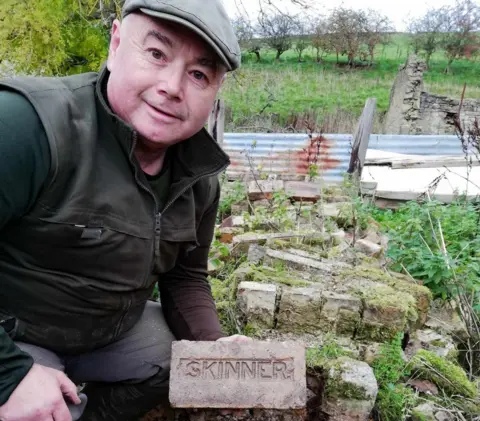 Chris Tilney
Chris TilneyChris Tilney has 2,000 bricks in his garden, give or take. His interest was piqued in 2018 and he's been "a bit obsessive" ever since. Five years later he's still on the hunt, scouring maps and swapping spares with other equally obsessed collectors.
The first one wasn't even a whole brick and Chris lost it as soon as he'd spotted it.
It was with some others down a hole dug by workmen and he thought he'd go back and ask for it.
"When I returned they'd filled the hole in and tarmacked the road again," he said, adding: "So I thought 'I think I'll go and look for some of those bricks'."
For Chris, as for many brick collectors, it's the names stamped on them that matter - the brickworks or colliery where they were made, the works' owner, or both.
Occasionally this puts them in competition with people who just fancy a pretty thing with a nice word on it. Bearing just his surname, Joseph Horatio Love's bricks are understandably quite popular as ornaments.
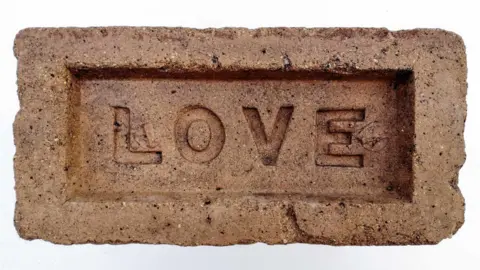 Chris Tilney
Chris TilneyChris' lost brick had Carr House on it, which he knew had been a brickworks in his home town of Consett in County Durham in the mid to late 1800s. It was also marked H [Henry] Ritson, the works' owner.
So Chris went on the hunt, scouting round waste ground and hedges.
"I found a load of bricks local to Consett," he said, adding: "And then it became obsessive - to look for more."
And there are plenty to find.
The north-east of England is so rich in scattered bricks because they tended to be made alongside coal mining, Chris says. Often a layer of clay was found either above or below the seam of coal so a brickworks would be built near the colliery and the results used either on-site or for workers' houses.
Move forward 170 years and those bricks are now scattered far and wide, dumped in the 1960s and '70s on waste ground that is now overgrown, used for river edging and now fallen into the water, discarded from ships that used them as ballast, and in collapsed heaps where old buildings have fallen down.
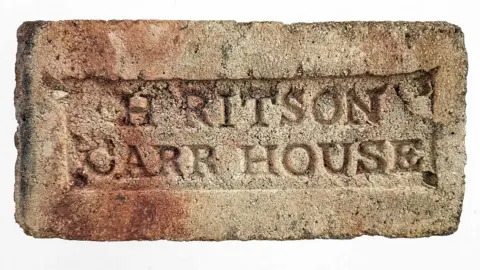 Chris Tilney
Chris TilneyChris and fellow brick collector Mike Graham follow the same method to find them, searching old maps on the internet for former brickworks and collieries and then checking with a modern map to see whether they've been built on.
"Some bricks I'm after from the Middlesbrough area, Linthorpe, you look at Google Earth and what was just farmers' fields is now back-to-back houses and gardens," Chris says, adding: "So very little chance of finding anything there.
"Unless you're lucky enough to go past some house that's getting demolished and the bricks are going into a skip, like if there's any work going on."
Forests, waste ground, streams, rivers and farmland, though, are ripe for scouring.
Always with permission, they both say. There is no fun in sneaking about, always "looking over your shoulder".
They have both decided to concentrate their efforts on North East bricks, but even that has taken Chris as far as Berwick and Hartlepool, Staindrop and Haltwhistle.
He still finds examples from Manchester, Leeds and further afield, but has no idea why an area awash with its own bricks would import them from other regions.
 Mike Graham
Mike GrahamMike, from Stanley in County Durham, caught the bug after knocking down a chimney breast in a house he was renovating and finding two bricks marked Fencehouses and Lambton.
A few months later he found another brick - stamped Washington - on a heap of fly-tipped rubbish and was hooked.
"It was mainly just me and my partner walking the dog at first," Mike says, adding: "We'd see a brick, turn it over, check it.
"Then it progressed to me delving knee-deep in the Tyne and the Tees and getting scruffy dirty and just getting much more serious."
At this point his partner decided to let him get on with it by himself. But, Mike says, she is still keen to see what he brings home from his travels.
As soon as he returns and parks the car in the drive, "she's straight out - 'what have you got?'".
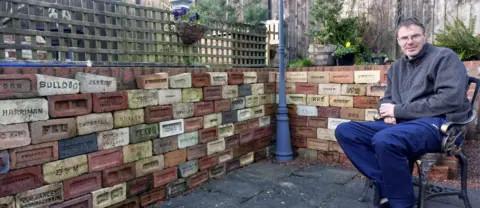 Ruth Pritchard
Ruth PritchardThe scale of brickmaking in the North East becomes clear when Mike says he has three or four hundred different bricks just from the local area "out on display in the garden".
When he started collecting, any brick with a name on would do so now duplicates and less pristine examples line a path in his allotment.
"When you actually do realise how many North East bricks there were, how many different styles from the same brickworks there were, you've got to limit yourself to one area," he says.
Chris has about 2,000 in his garden and shed, possibly one of the largest collections in the region.
His wife is not delighted with this state of affairs.
"When she sees us walking into the yard with a rucksack and start emptying my rucksack of bricks, and [emptying] the boot of bricks and piling them up in the yard, ready to clean, she's not too happy, like," he says.
"She'd actually sooner see something permanent built in the garden," Chris says, adding: "Some sort of feature, she doesn't mind that, but she just sees stacks of bricks around the edge of the garden.
"It doesn't look untidy. I think it looks quite nice."
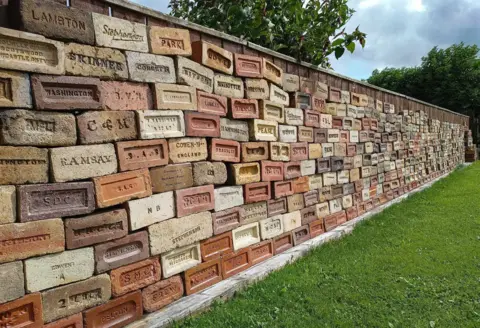 Chris Tilney
Chris TilneyThe "stacks" are formed into a temporary wall leaning against his fence, some 4ft (1.2m) high. During Storm Arwen he thought: "I better take that down because they'll all just be in a pile in the morning when I get up, and a lot of them will be broken."
So each winter it comes down, and each spring it goes back up.
"It's just nice to go out on a nice morning and look at the names on the bricks, and all the various colours," he says.
But the need to thin his collection was one of the reasons Chris offered to donate his duplicates - some of them quite rare, he says - to Path Head water mill in Blaydon.
"So that people can go and enjoy them," he says.
He has more should a museum want to put them on display, he adds.
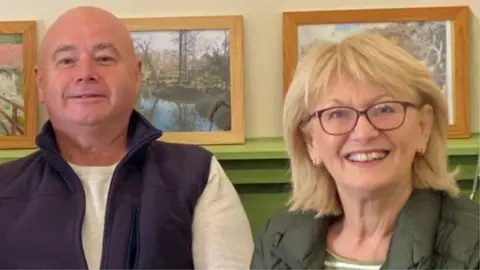 Kevin Boyle
Kevin Boyle Val Scully, a local history expert and author who volunteers at the water mill, was already interested in bricks when she met Chris.
Research into the nearby Gibside estate had led her to local author Peter Davison and his out-of-print book Brickworks of the North East. She asked if the water mill's publishing press could reprint it and, within a few months of mentioning it on a brick enthusiasts' Facebook page, had made £700.
And then she stumbled across a post from Chris, who had been looking for the book.
"It was so astonishing, it was like having the stars aligned," Val says, adding: "He just immediately came back and said 'would Path Head like a brick heritage monument?'.
"So, throughout that hot summer last year, he and his son - his son would come after a day's work as a brickie and Chris laboured for his son - the two of them built the wall.
"It was just a marvellous act of generosity."
And an act of faith in the suspension of his car, as Chris transported 70 bricks at a time spread out all over the footwells and the boot.
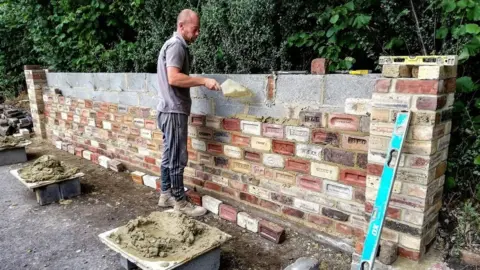 Val Scully
Val ScullySince then, Chris has run three brick swap events at the water mill with another planned for the spring.
Enthusiasts have come from Lincolnshire, Lancashire, Scotland and Derby, and Chris says he's had interest from South Wales.
He takes along 30 or 40 of his duplicates, lays them out on display and runs a raffle, with the proceeds going to Path Head.
Friendships have been made between the swappers who "enjoyed the mutual interest" of like-minded collectors.
"Because sometimes you can be looked on as a bit strange, collecting bricks," he says.
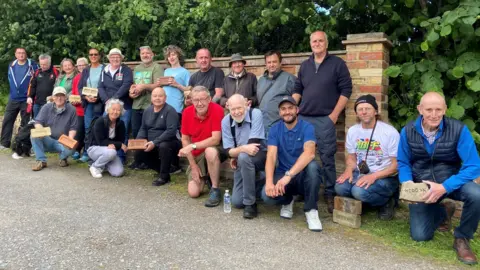 Val Scully
Val ScullyVal hadn't been sure how many people would come to the swaps, but the first group arrived from Scotland and were there by 09:00.
"We opened the wagonway and they all had their bricks in their boots and they were just the most amiable bunch of people," she says.
She comments on their helpfulness towards each other and their enthusiasm for this or that new find.
After the first swap, wellies were pulled on and they all "plodged off down into Blaydon Burn where Cowen's brickworks were and came back beaming with what they'd found", she says.
The camaraderie only goes so far, though.
Mike often brings back bricks he already has for other people he knows would want them. But he has found a rich spot on the River Tees that he is not sharing just yet.
"Maybe when I've cleared the site and I think I've done it all I'll let them know exactly where I was," he says, laughing.
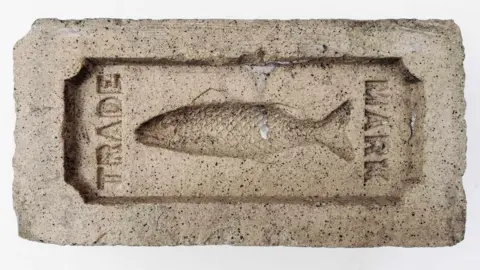 Chris Tilney
Chris TilneyThe appeal is clearly infectious. Val talks with evident enthusiasm about a brick with a "most beautiful fish" pattern, hollow and with defined scales.
"I really wanted one, but he [Chris] didn't have another one, so it had to go in the wall," she says, adding: "I absolutely adore them."
The thing about these patterns, Val points out, is that they're hidden in the built structure because they're on the sides that join the bricks above and below.
"So some of these walls, which look like plain walls, have got little hidden gems of art in the mortar," she says.
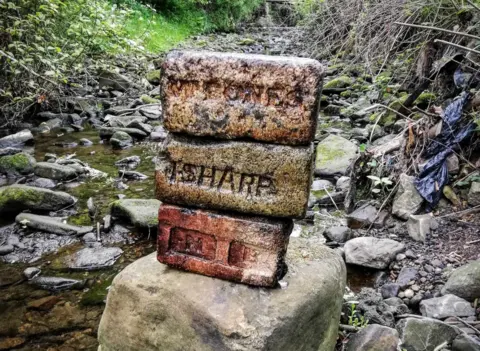 Chris Tilney
Chris TilneyMike says the hobby is a welcome tonic.
He works permanent night shifts in a busy distribution centre and finds a couple of hours out in the fresh air after a hard night very relaxing.
"I finished yesterday morning, half past eight, after doing a full night shift and I was on the Tees for six hours," he says.
"Tiredness just doesn't come into it because it's an addictive, relaxing, enjoyable hobby. It really is."
Now retired, Chris used to be out every other day, dropping his wife at work and taking himself off to somewhere he had researched.
Cancer and the effects of his medication have "curtailed things a bit" but the bricks in his collection have been a welcome distraction.
"It's strange how everything's just out of your mind," he says, adding: "It's a great hobby for distracting from other worse things going on in my life.
"When I'm looking for bricks I just think of nothing else.
"Just focusing, looking for something with a name on."
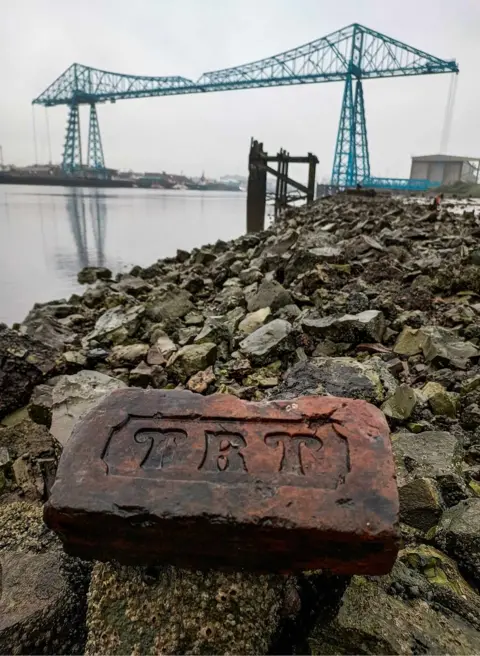 Chris Tilney
Chris TilneyAll pictures subject to copyright

Follow BBC North East on Facebook, X (formerly Twitter), and Instagram. Send your story ideas to [email protected].
